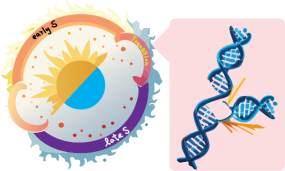Selected Publications
New Publication

© Pei-Chi Wei @ DKFZ
The human brain has more than 80 billion neurons, which are cells that connect to form a network controlling our actions, thoughts, and behaviors. Neurons are produced early in life, mainly during the embryonic stage, and they remain with us throughout our lifetime. The precursor cells for neurons are called neural progenitor cells, which multiply numerous times before becoming neurons. During this process, the DNA inside the cells must replicate itself accurately. When errors occur, the DNA can break, leaving scars that can be inherited by subsequent generations of neurons, affecting normal brain function. Many neuropsychiatric disorders, such as schizophrenia and autism spectrum disorder, show recurrent scars in the DNA of neurons. These scar "hotspots" are primarily found in neuronal cells and disrupt the function of important genes that control how neurons communicate with each other. However, why neural cells develop these hotspots in their genome remains unclear.
The study, led by two Ph.D. students at the DKFZ, Corazzi and Ionasz et al., has unraveled a long-standing mystery. Using a laboratory culture system, they discovered that DNA scar hotspots—clusters of recurrent DNA breaks—primarily occur during the replication of cells' DNA. They grew millions of neural progenitor cells from embryonic stem cells in a dish and examined where and when these DNA scars appeared. They found that most of the DNA scars appeared specifically when cells transitioned between different stages of DNA duplication. Initially, when cells begin duplicating their DNA, the damage is mostly confined to areas of the genome that produce large amounts of RNA. However, as cells transition from early to late stages of DNA duplication, the number of hotspots increases tenfold. These hotspots are mainly caused by the collision between two processes: DNA duplication and gene transcription. Essentially, when DNA replication and RNA transcription occur in opposite directions—like two trains moving in opposite directions on the same track—they collide and create DNA breaks. This collision becomes even more pronounced when DNA replication is inhibited, resulting in over a hundred hotspots appearing in the genome of neural progenitor cells. Moreover, these hotspots primarily affect genes associated with neuropsychiatric disorders and cancers. This phenomenon is unique to neural progenitor cells and has not been observed before. In summary, Corazzi and Ionasz et al. have described a novel mechanism for why these hotspots occur in neuronal cells and how we might prevent them from affecting developing embryos.
This paper is now published in Nature Communications.
https://www.nature.com/articles/s41467-024-47934-w
List of Publications
1.Corazzi L*, Ionasz V*, Andrejev S, Wang LC, Vouzas A, Giaisi M, Di Muzio G, Ding B, Marx AJM, Henkenjohann J, Allers MM, Gilbert DM, Wei PC§. Linear Interaction Between Replication and Transcription Shapes DNA Break Dynamics at Recurrent DNA Break Clusters. (2024) Nature Communications. Nat Commun 15, 3594
2. Tena, A., Zhang, Y., Kyritsis, N., Devorak, A., Zurita, J., Wei, PC#, and Alt, FW#. Induction of recurrent break cluster genes in neural progenitor cells differentiated from embryonic stem cells in culture. (2020). Proceedings of the National Academy of Sciences U S A 117(19):10541–10546
3. Wang, M., Wei, PC., Lim, C.K., Gallina, I.S., Marshall, S., Marchetto, M.C., Alt, F.W., and Gage, F.H. Increased Neural Progenitor Proliferation in a hiPSC Model of Autism Induces Replication Stress-Associated Genome Instability. (2020). Cell Stem Cell 26, 221-233.e6.
4. Wei PC*, Lee CS*, Du Z, Schwer B, Zhang Y, Kao J, Zurita J, Alt FW. Three classes of recurrent DNA break clusters in brain progenitors identified by 3D proximity-based break joining assay. (2018) Proceedings of the National Academy of Sciences U S A, 115(8):1919-192.
5. Wei PC*, Chang AN*, Kao J, Du Z, Meyers RM, Alt FW#, Schwer B#. Long neural genes harbor recurrent DNA break clusters in neural stem/progenitor cells. (2016) Cell. 164(4):644-55.
6. Schwer B*, Wei PC*, Chang AN, Kao J, Du Z, Meyers RM, Alt FW. Transcription-associated processes cause DNA double-strand breaks and translocations in neural stem/progenitor cells. (2016) Proceedings of the National Academy of Sciences U S A. 113(8):2258-63.
7. Huang SC, Wei PC, Hwang-Verslues WW, Kuo WH, Jeng YM, Hu CM, Shew JY, Huang CS, Chang KJ, Lee EY, Lee WH. TGF-β1 secreted by Tregs in lymph nodes promotes breast cancer malignancy via up-regulation of IL-17RB. (2017) EMBO Mol Med. pii: e201606914. PMID: 28993429
8. Alt FW, Wei PC, and Schwer B. Recurrently breaking genes in neural progenitors: potential roles of DNA breaks in neuronal function, degeneration and cancer. (2017) Genome Editing in Neurosciences (Jaenisch, R. Zhang, F., and Gage, F., Eds); p63-72.
9. Wei PC*, Hsieh YH*, Su MI*, Jiang X, Hsu PH, Lo WT, Weng JY, Jeng YM, Wang JM, Chen PL, Chang YC, Lee KF, Tsai MD, Shew JY, Lee WH. Loss of the oxidative stress sensor NPGPx compromises GRP78 chaperone activity and induces systemic disease. (2012) Mol Cell. 48(5):747-59.
